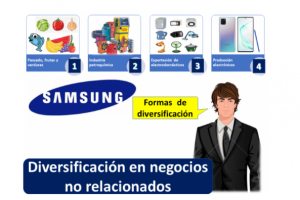DIVERSIFICATION STRATEGIES
Accelerate your business with these expert tips on "Diversification strategies". Analyse and discover this TIP!
Diversification strategies are used by companies to expand their market presence and reduce the risk of relying on a single product or service. The strategy of diversification ands the one used by a company when it decides to expand its sources of income, this allows it to achieve expansion and growth.
Advice to entrepreneurs wishing to diversify
Some tips for implementing a diversification strategy include:
- Ensure that the new product or service line fits the company's culture.
- Maintain clear and open communication with employees and customers about upcoming changes.
- Do not stray too far from the mission and values of the original company.
When is the right time to diversify a company?
The right time to diversify a company will depend on the strategy and objectives of the particular company. However, diversification is generally considered an attractive option when the company has already established its position in the market and has a steady revenue stream. In addition, before diversifying, it is important for the company to carefully assess the growth opportunities, revenue potential and level of risk associated with each new line of business. Diversification can be a high-risk strategy, so a company must have a solid understanding of the markets it plans to enter and be prepared to make significant investments in time and resources.
Diversifying too early is very dangerous because it can scatter you, lose focus!
A practical exercise for entrepreneurs to practice with the diversification strategy would be to look at their current business and consider how they could expand their product or service offering in a related or unrelated way. They should then research the market and competition to determine if there is an unmet need that they could satisfy and assess the resources needed to implement the strategy. When diversification strategies are used, companies will be able to reach other markets and take advantage of new business opportunities. These strategies are widely used by companies aiming for growth.
Types of business diversification
In addition, a company can use diversification to expand through related or unrelated businesses. There are two types of diversification strategies: related diversification and unrelated diversification.
DIVERSIFICATION INTO RELATED BUSINESSES
Related diversification occurs when a company decides to expand its market presence by offering new products or services that are related to the products or services it already offers. This is done to take advantage of the company's experience and expertise in a given area. Diversification into related businesses occurs when they can take advantage of certain similarities in the processes or resources used by the company. This could be similarity in markets, embedded technology, distribution channels used and any other resources that help them complement each other. That is to say, the relationship can be at the production, consumption or marketing level. This allows companies to become more efficient at diversifying.
BUSINESS DIVERSIFICATION CAN BE OF TWO TYPES:
HORIZONTAL
Horizontal diversification therefore occurs when companies expand the ranges of related products they offer to the market. This could be, for example, a company that produces and markets shampoo and now produces conditioners, foams and hair dyes. Also, it could be the case that a company starts to produce complementary products, such as a company that produces toothpaste and now decides to produce toothbrushes.
VERTICAL
Vertical diversification occurs when companies start producing intermediate products that will be used to produce their final product. For example, a company that produces biscuits might produce flour. Indeed, this gives it the advantage that it is not dependent on a flour supplier, because it produces its own inputs. This means that the company is not dependent on another company to carry out its production process.

Diversification into unrelated businesses
On the other hand, unrelated diversification occurs when a company decides to expand its market presence by offering products or services that are unrelated to the products or services it already offers. This approach is often used to reduce the risk of relying on a single product or service. Unrelated diversification is generated when the company decides to engage in an activity that is totally different from the one it normally engages in. This implies that there is no similarity in their consumption, production and marketing processes. Accordingly, This strategy is riskier because the company enters markets that are completely different from what it produces and markets. Therefore, it does not have any experience. One of the most important examples of companies that managed to be successful through this kind of diversification is the case of Samsung.
Samsung initially started out trading fish, vegetables and fruit. It then moved into the petrochemical industry, then into exporting household appliances. Finally, it ventured into the electronics market, especially with the production of mobile phones, where it is now recognised as a market leader.

By way of conclusion, we can say that diversification strategies are designed and implemented when companies seek to achieve expansion and growth. The way they can do this is by diversifying into related businesses if they want to take advantage of the similarity of firms in consumption, production or marketing processes. They can also diversify into unrelated businesses, where the risk is greatest because these are activities in which the company has no experience.
APPLY THIS TIP TO YOUR PROJECT
QUIZZES
- 💻 PRACTICE with an expert in the next practical webinar.
- 🔎 CONSULT more related TIPs with this same theme.
- 📖 AMPLIA your knowledge by downloading this EBOOK.
THINK ABOUT YOU
- 🚀 IMPULSA your company in the next acceleration programme, ¡book your place now!
- 🥁 PRACTICE with your project in this practical webinar, ¡apply for your place!.
- 🌐 CONTACT with other entrepreneurs and companies, ¡register and take part in the next Networking!
THINK ABOUT HELPING OTHERS
- 🤝COLLABORATE as a volunteer: expert, mentor, inverter, awarding, Spreading the word, challenging, innovating, creating a TIP...
- 💬 RECOMMENDS this programme to reach out to more entrepreneurs by Google.
- 👉 SHARE your learning!
- 📲 SEND this TIP 👇
Rate this TIP!
Click on the stars to rate
Rating "0" - Average " - Average0"
No votes yet, be the first to vote!
We are sorry you did not find it useful.
Help us improve this TIP!
Leave us a comment and tell us how you would improve this TIP









